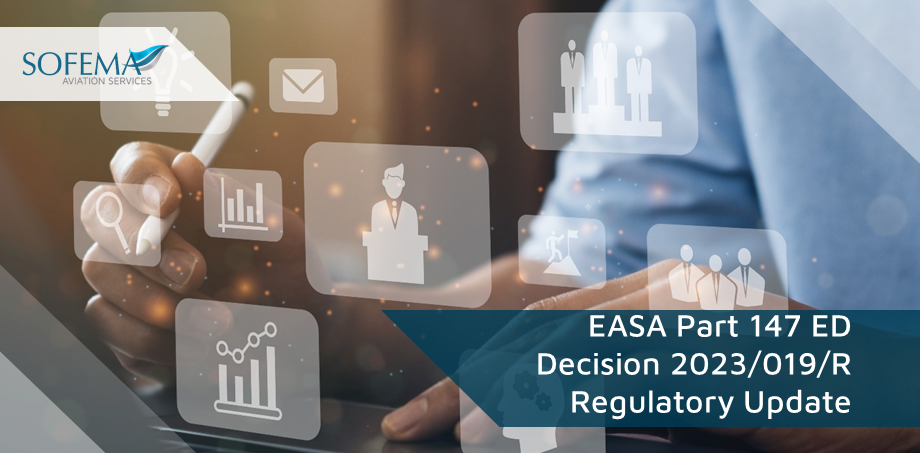Sofema Aviation Services (SAS) www.sassofia.com considers the role and purpose of “AMC & GM to EASA Part 147 ED Decision 2023/019/R Part-147 — Issue 2, Amendment 3” related to training requirements, methodologies and technical integration.
Introduction
The “AMC & GM to Part-147 — Issue 2, Amendment 3” outlined in Annex III to ED Decision 2023/019/R introduces significant updates to the Acceptable Means of Compliance (AMC) and Guidance Material (GM) for Annex IV (Part-147) to Commission Regulation (EU) No 1321/2014.
- These amendments reflect the ongoing evolution of training requirements and methodologies in the aviation maintenance sector, emphasizing flexibility, technological integration, and enhanced quality assurance measures.
Consider the following summary and analysis of the key changes and their implications for aviation maintenance training organizations.
- Facility Requirements, – The amendment emphasizes the adequacy of student numbers about the nature and conditions of training to ensure effective interaction between instructors and students.
o This is critical in maintaining the quality of education and ensuring that pedagogical and human factors principles are adhered to.
- For approved basic maintenance training courses, there is now a clearer directive on the need for holding and ensuring access to a wide array of documentation, including EU regulations, national aviation legislation, maintenance manuals, and airworthiness directives.
o The inclusion of avionics documentation covering a broad range of equipment underscores the growing importance of avionics in maintenance training.
- Personnel Requirements – A distinction is made between larger and smaller maintenance training organizations regarding the appointment of management roles.
o This change allows for greater flexibility in staffing, recognizing the varying capacities of organizations while ensuring that all functions are properly carried out.
- Instructors are required to be trained in the subjects they deliver, including appropriate training methods and tools.
o There’s a recommendation for instructors to be trained in instructional techniques, especially those utilizing new training technologies.
o This acknowledges the shift towards digital learning environments and the need for instructors to be adept in these settings.
- Instructional Equipment and Training Procedures – There is a push towards the use of synthetic training devices and virtually controlled environments for knowledge transfer.
o This aligns with the industry’s move towards more technologically advanced training methods, such as computer-based and multimedia-based training, which can enhance learning outcomes through interactive and engaging materials.
- The amendments also address the need for maintenance training organizations to ensure computer system requirements are known to end users, and for activities to be traceable, documented, and recorded.
o is crucial for maintaining the integrity and effectiveness of the training process.
- Quality System and – The updates provide a structured approach to the selection of training tools and methods, emphasizing the combination of different methods and tools to fulfil learning objectives.
o This flexibility in training approaches is designed to cater to various learning styles and the diverse needs of students.
- Distance Learning – The amendments recognize the validity of distance learning, including the delivery of training and examinations via URL addresses.
o This flexibility is particularly relevant in today’s educational environment, where remote learning has become increasingly prevalent.
- Competent Authorities – The role of competent authorities is elaborated to include knowledge of maintenance training standards and training methods and technologies, highlighting the importance of regulatory bodies being up-to-date with current training practices and technologies.
Summary
“AMC & GM to Part-147 — Issue 2, Amendment 3” reflects a modern approach to aviation maintenance training, recognizing the importance of technological integration, flexibility in training delivery, and the need for comprehensive quality assurance mechanisms.
These amendments will likely enhance the effectiveness of training programs, ensuring that maintenance personnel are well-equipped with the necessary skills and knowledge to meet the demands of the aviation industry. For training organizations, adapting to these changes will be crucial in maintaining accreditation and delivering high-quality training to their students.
Next Steps
Follow this link to our Library to find & download related documents for Free.
Sofema Aviation Services (SAS) www.sassofia.com and Sofema Online (SOL) www.sofemaonline.com provides Classroom, Webinar and Online Training related to EASA Part 147 and Part 66 Regulatory Requirements – Please see the websites or email team@sassofia.com
Tags:
"AMC & GM to Part-147 — Issue 2, Acceptable means of compliance (AMC), Amendment 3, Annex III to ED Decision 2023/019/R, Annex IV (Part-147) to Commission Regulation (EU) No 1321/2014., Aviation Maintenance, Competent Authorities, EASA Part 147, EASA Part 147 ED Decision 2023/019/R, Facility Requirements, Guidance material (GM), Instructional Equipment, Part 66 Regulatory Requirements, Personnel requirements, Quality System, SAS blogs, SAS Download Area, Training Evaluation




